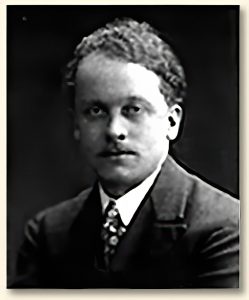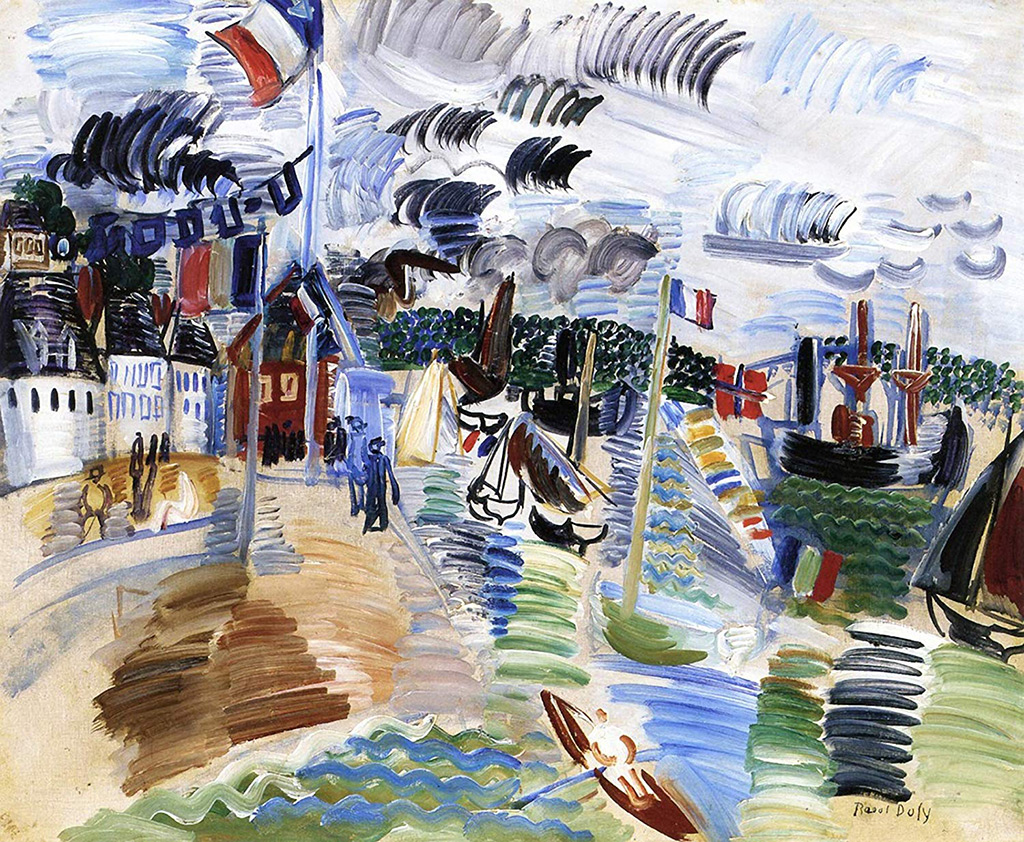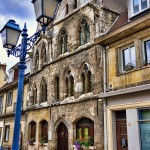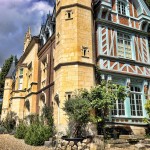This page forms part of a series of pages dedicated to the many artists who painted in Caudebec-en-Caux. A full list of all the artists with a link to their works can be found at the bottom of this page.
NOTE: Caudebec-en-Caux has recently merged (2016) with other towns nearby and is now called “Rives-en-Seine“. However, since the artists called the town by its original name in their paintings, we will continue to refer to the place by its old name.

Movement(s): Cubism, Fauvism, Impressionism, Modernism
Raoul Dufy (1877 – 1953) was a French Fauvist painter, brother of Jean Dufy. He developed a colorful, decorative style that became fashionable for designs of ceramics and textiles, as well as decorative schemes for public buildings. He is noted for scenes of open-air social events. He was also a draftsman, printmaker, book illustrator, scenic designer, a designer of furniture, and a planner of public spaces.
Raoul Dufy was born into a large family at Le Havre, in Normandy. He left school at the age of fourteen to work in a coffee-importing company. In 1895, when he was 18, he started taking evening classes in art at Le Havre’s École des Beaux-Arts (municipal art school).
The classes were taught by Charles L’Huillier, who had been, forty years earlier, a student of the French portrait-painter, Ingres. There, Dufy met Raimond Lecourt and Othon Friesz with whom he later shared a studio in Montmartre and to whom he remained a lifelong friend (he also met the de Saint-Delis brothers there, Henri de Saint-Delis and Rene de Saint-Delis). During this period, Dufy painted mostly Norman landscapes in watercolors.
In 1900, after a year of military service, Dufy won a scholarship to the École nationale supérieure des Beaux-Arts in Paris, where again he crossed paths with Othon Friesz. He concentrated on improving his drawing skills. The impressionist landscape painters, such as Claude Monet and Camille Pissarro, influenced Dufy profoundly. His first exhibition (at the Exhibition of French Artists) took place in 1901.
Introduced to Berthe Weill in 1902, Dufy showed his work in her gallery. Then he exhibited again in 1903 at the Salon des Indépendants. A boost to his confidence: the painter, Maurice Denis, bought one of his paintings. Dufy continued to paint, often in the vicinity of Le Havre, and, in particular, on the beach at Sainte-Adresse, made famous by Eugene Boudin and Claude Monet. In 1904, with his friend, Albert Marquet, he worked in Fecamp on the English Channel (La Manche).
By 1950, his hands were struck with rheumatoid arthritis and his ability to paint diminished, as he had to fasten the brush to his hand. In April he went to Boston to undergo an experimental treatment with cortisone and corticotropin, based on the work of Philip S. Hench.
It proved successful, and some of his next works were dedicated to the doctors and researchers in the United States. In 1952 he received the grand prize for painting in the 26th Venice Biennale.
Dufy died at Forcalquier, France, on 23 March 1953, of intestinal bleeding, which was a likely result of his continuous treatment. He was buried near Matisse in the Cimiez Monastery Cemetery in Cimiez, a suburb of the city of Nice.
Click here to read Raoul Dufy’s full bio on Wikipedia.
Despite making many paintings in Normandy, we found only one of his of Caudebec-en-Caux.
NOTE: Click on the image below for a bigger version (no new window will open).
Raoul Dufy painted in several places in France (but notably in Normandy), the list is shown below (a link “⇠” to the works for each city will appear below when published):
- Grand Est
- Langres
- Normandy
- Bayeux (surrounding only) ⇠
- Nonant ⇠
- Caudebec-en-Caux ⇠
- Deauville ⇠
- Falaise
- Fecamp ⇠
- Honfleur
- Le Havre (and surroundings) ⇠
- Trouville-sur-Mer (and surroundings) ⇠
- Bayeux (surrounding only) ⇠
- Occitanie
- Perpignan
- Vernet-les-Bains
- Pays de la Loire
- Brissac Loire Aubance
- Provence-Alpes-Cote d’Azur
- Antibes
- Cannes
- Golfe-Juan
- Hyeres
- Marseilles
- Nice
- Saint-Jeannet
- Vallauris
- Villefranche-sur-Mer
Artists featured here who painted in Caudebec-en-Caux (but not limited to) are (names marked with a “*” indicates that the artist did NOT work directly in Caudebec, instead worked in villages nearby):
- 🇫🇷 Binet, George ⇠
- 🇺🇸 Boggs, Frank Myers ⇠
- 🇬🇧 Bonington, Richard Parkes ⇠
- 🇫🇷 Boudan, Louis ⇠
- 🇫🇷 Boudin, Eugene-Louis ⇠
- 🇬🇧 Boys, Thomas Shotter * ⇠
- 🇬🇧 Burgess Jr, John * ⇠
- 🇬🇧 Callow, William ⇠
- 🇬🇧 Cameron, David Young ⇠
- 🇬🇧 Childers, Milly ⇠
- 🇫🇷 Corot, Jean-Baptiste Camille * ⇠
- 🇬🇧 Cundall, Charles ⇠
- 🇦🇺 Davies, David ⇠
- 🇬🇧 Dolby, Edwin ⇠
- 🇫🇷 Dufy, Raoul ⇠
- 🇫🇷 Garneray, Ambroise Louis ⇠
- 🇫🇷 Gernez, Paul-Elie ⇠
- 🇫🇷 Gudin, Theodore ⇠
- 🇫🇷 Lemaitre, Leon-Jules ⇠
- 🇫🇷 Letellier, Emile-Andre ⇠
- 🇬🇧 Prout, Samuel * ⇠
- 🇬🇧 Schafer, Henry Thomas ⇠
- 🇬🇧 Smallwood, William Frome * ⇠
- 🇬🇧 Talbot, Rosamund Constance ⇠
- 🇫🇷 Thorigny, Felix * ⇠
- 🇬🇧 Turner, Joseph Mallord William ⇠
NOTE: You can subscribe to our new articles by entering your email address in the box on the right column (or at the very bottom of this article) and clicking on the button “Subscribe”.
You will need to check your incoming emails and validate your subscription. If you can’t see an email from us, check your Spam folder. Without validating your email address, you will not get notifications from us. WE WILL NEVER GIVE YOUR EMAIL ADDRESSES TO ANYONE!
Related Posts
- 10000
- 10000
- 10000
 Transport Getting There Ferry: Closest ferry harbours from the UK are Dieppe and Le Havre. Within Caudebec-en-Caux Caudebec is so small that you can walk from one end to the other in 10 minutes. Restaurants There are a couple of restaurants (normal French food, crepes, pizza), but only one springs…
Transport Getting There Ferry: Closest ferry harbours from the UK are Dieppe and Le Havre. Within Caudebec-en-Caux Caudebec is so small that you can walk from one end to the other in 10 minutes. Restaurants There are a couple of restaurants (normal French food, crepes, pizza), but only one springs… - 10000
- 93





